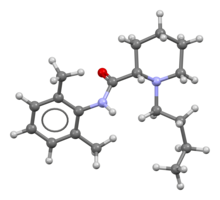Bupivacaine
 | |
 | |
| Clinical data | |
|---|---|
| Pronunciation | /bjuːˈpɪvəkeɪn/ |
| Trade names | Marcaine, Sensorcaine, Posimir, others |
| AHFS/Drugs.com | Monograph |
| License data |
|
| Pregnancy category |
|
topical, implant | |
| ATC code | |
| Legal status | |
| Legal status | |
| Pharmacokinetic data | |
| Bioavailability | n/a |
| Protein binding | 95% |
| Metabolism | Liver |
| Onset of action | Within 15 min[5] |
| Elimination half-life | 3.1 hours (adults)[5] 8.1 hours (neonates)[5] |
| Duration of action | 2 to 8 hr[6] |
| Excretion | Kidney, 4–10% |
| Identifiers | |
| |
JSmol) | |
| Melting point | 107 to 108 °C (225 to 226 °F) |
| |
| |
| | |
Bupivacaine, marketed under the brand name Marcaine among others, is a medication used to
Possible side effects include sleepiness, muscle twitching,
Bupivacaine was discovered in 1957.
Medical uses
Bupivacaine is
The
Bupivacaine (Posimir) is indicated in adults for administration into the subacromial space under direct arthroscopic visualization to produce post-surgical analgesia for up to 72 hours following arthroscopic subacromial decompression.[11][18]
Contraindications
Bupivacaine is contraindicated in patients with known hypersensitivity reactions to bupivacaine or amino-amide anesthetics. It is also contraindicated in obstetrical paracervical blocks and intravenous regional anaesthesia (
Adverse effects
Compared to other local anaesthetics, bupivacaine is markedly
Clinically significant adverse events result from systemic absorption of bupivacaine and primarily involve the central nervous and cardiovascular systems. Effects on the central nervous system typically occur at lower blood plasma concentrations. Initially, cortical inhibitory pathways are selectively inhibited, causing symptoms of neuronal excitation. At higher plasma concentrations, both inhibitory and excitatory pathways are inhibited, causing central nervous system depression and potentially coma. Higher plasma concentrations also lead to cardiovascular effects, though cardiovascular collapse may also occur with low concentrations.[21] Adverse effects on the central nervous system may indicate impending cardiotoxicity and should be carefully monitored.[19]
- Central nervous system: circumoral numbness, facial tingling, vertigo, tinnitus, restlessness, anxiety, dizziness, seizure, coma
- Cardiovascular:
Toxicity can also occur in the setting of subarachnoid injection during high spinal anesthesia. These effects include: paresthesia, paralysis, apnea, hypoventilation, fecal incontinence, and urinary incontinence. Additionally, bupivacaine can cause chondrolysis after continuous infusion into a joint space.[19]
Bupivacaine has caused several deaths when the epidural anaesthetic has been administered intravenously accidentally.[22]
Treatment of overdose
Animal evidence
Pregnancy and lactation
Bupivacaine crosses the placenta and is a pregnancy category C drug. However, it is approved for use at term in obstetrical anesthesia. Bupivacaine is excreted in breast milk. Risks of stopping breast feeding versus stopping bupivacaine should be discussed with the patient.[19]
Postarthroscopic glenohumeral chondrolysis
Bupivacaine is toxic to cartilage and its intra-articular infusions may lead to postarthroscopic glenohumeral chondrolysis.[28]
Pharmacology
Pharmacodynamics
Bupivacaine binds to the intracellular portion of voltage-gated
Pharmacokinetics
The rate of systemic absorption of bupivacaine and other local anesthetics is dependent upon the dose and concentration of drug administered, the route of administration, the vascularity of the administration site, and the presence or absence of epinephrine in the preparation.[29]
- Onset of action (route and dose-dependent): 1–17 min
- Duration of action (route and dose-dependent): 2–9 hr
- Half life: neonates, 8.1 hr, adults: 2.7 hr
- Time to peak plasma concentration (for peripheral, epidural, or caudal block): 30–45 min
- Protein binding: about 95%
- Metabolism: hepatic
- Excretion: renal (6% unchanged)[19]
Chemical structure
Like
Society and culture
Legal status
On 17 September 2020, the Committee for Medicinal Products for Human Use (CHMP) of the European Medicines Agency (EMA) adopted a positive opinion, recommending the granting of a marketing authorization for the medicinal product Exparel, intended for the treatment of post-operative pain.[30] The applicant for this medicinal product is Pacira Ireland Limited.[30] Exparel liposomal was approved for medical use in the European Union in November 2020.[31]
Economics
Bupivacaine is available as a
Research
Levobupivacaine is the (S)-(–)-enantiomer of bupivacaine, with a longer duration of action, producing less vasodilation. Durect Corporation is developing a biodegradable, controlled-release drug delivery system for after surgery. As of 2010, it has completed a phase-III clinical trial.[32]
See also
References
- ^ "Bupivacaine Use During Pregnancy". Drugs.com. 13 April 2020. Retrieved 21 September 2020.
- FDA. Retrieved 22 October 2023.
- ^ "Marcaine- bupivacaine hydrochloride injection, solution Marcaine with epinephrine- bupivacaine hydrochloride and epinephrine bitartrate injection, solution". DailyMed. Retrieved 13 February 2021.
- ^ "Sensorcaine MPF- bupivacaine hydrochloride injection, solution". DailyMed. Retrieved 13 February 2021.
- ^ a b c d e f g h i j k l m n "Bupivacaine Hydrochloride". The American Society of Health-System Pharmacists. Archived from the original on 30 June 2015. Retrieved 1 August 2015.
- ^ ISBN 9780521433792. Archivedfrom the original on 5 October 2015.
- ISBN 9781437716795. Archivedfrom the original on 12 May 2016.
- hdl:10665/345533. WHO/MHP/HPS/EML/2021.02.
- ^ ISBN 9781284057560.
- ^ "Xaracoll: FDA-Approved Drugs". U.S. Food and Drug Administration (FDA). Retrieved 2 September 2020.
- ^ a b c "FDA approval letter" (PDF). U.S. Food and Drug Administration (FDA). 28 August 2020. Retrieved 2 September 2020.
 This article incorporates text from this source, which is in the public domain.
This article incorporates text from this source, which is in the public domain.
- ^ a b "FDA Approves Xaracoll (bupivacaine HCl) Implant, a Non-opioid, Drug-device Treatment Option for Acute Postsurgical Pain Relief for up to 24 Hours Following Open Inguinal Hernia Repair in Adults" (Press release). Innocoll Pharmaceuticals. 31 August 2020. Retrieved 2 September 2020 – via PR Newswire.
- ^ Lexicomp. "Bupivacaine (Lexi-Drugs)". Archived from the original on 10 April 2014. Retrieved 20 April 2014.
- ^ a b c Miller RD (2 November 2006). Basics of Anesthesia. Churchill Livingstone.
- PMID 33372953.
- PMID 28640101.
- PMID 28802777.
- ^ "Durect Corporation Announces U.S. FDA Approval of Posimir For Post-Surgical Pain Reduction for up to 72 Hours Following Arthroscopic Subacromial Decompression" (Press release). Durect Corporation. 2 February 2021. Retrieved 13 February 2021 – via PR Newswire.
- ^ a b c d e f g "Bupivacaine (Lexi-Drugs)". Archived from the original on 10 April 2014. Retrieved 20 April 2014.
- PMID 8287299.
- ISBN 978-0-9757919-2-9.
- ^ "Filipino nurse dies in UK due to wrong use of anaesthetic". ABS-CBN Interactive. 28 January 2014. Archived from the original on 9 July 2007.
- S2CID 1661916.
- S2CID 6247454.
- S2CID 40214528.
- S2CID 43125067.
- S2CID 29843241.
- PMID 27047224.
- ^ "bupivacaine hydrochloride (Bupivacaine Hydrochloride) injection, solution". FDA. Archived from the original on 21 April 2014. Retrieved 20 April 2014.
- ^ a b "Exparel: Pending EC decision". European Medicines Agency (EMA). 17 September 2020. Archived from the original on 23 September 2020. Retrieved 21 September 2020. Text was copied from this source which is © European Medicines Agency. Reproduction is authorized provided the source is acknowledged.
- ^ "Exparel liposomal EPAR". European Medicines Agency (EMA). 15 September 2020. Retrieved 11 December 2020.
- ^ "Bupivacaine Effectiveness and Safety in SABER Trial (BESST)". ClinicalTrials.gov. 20 January 2010. Archived from the original on 27 December 2011. Retrieved 1 March 2012.
